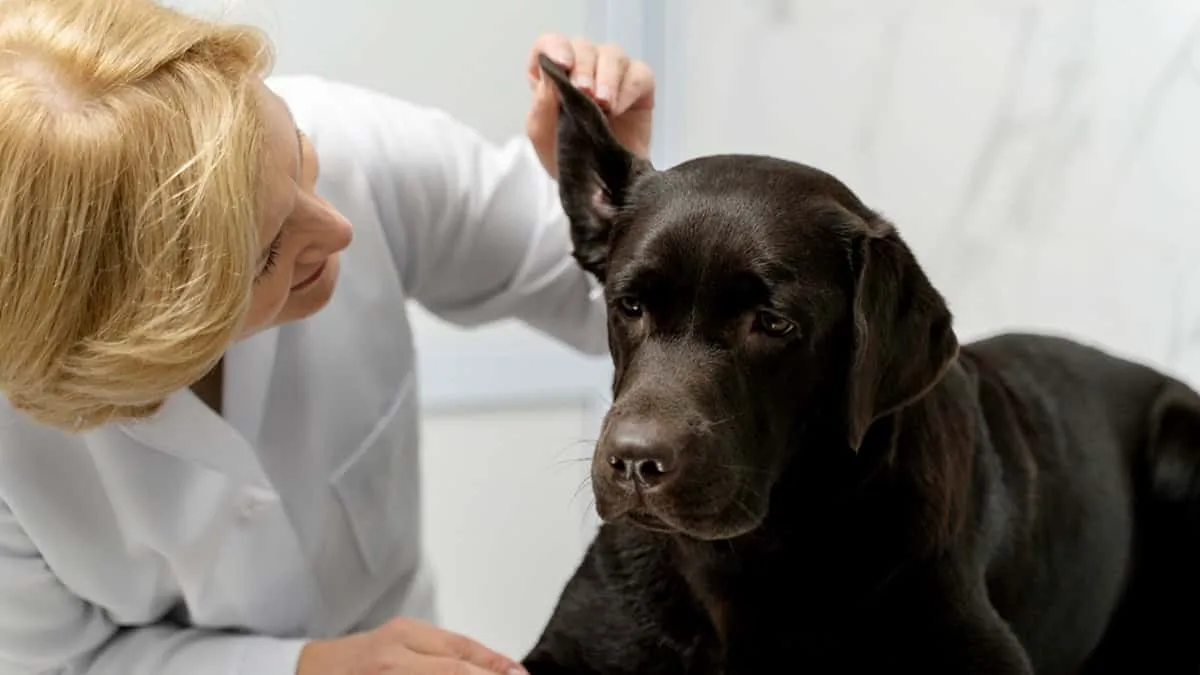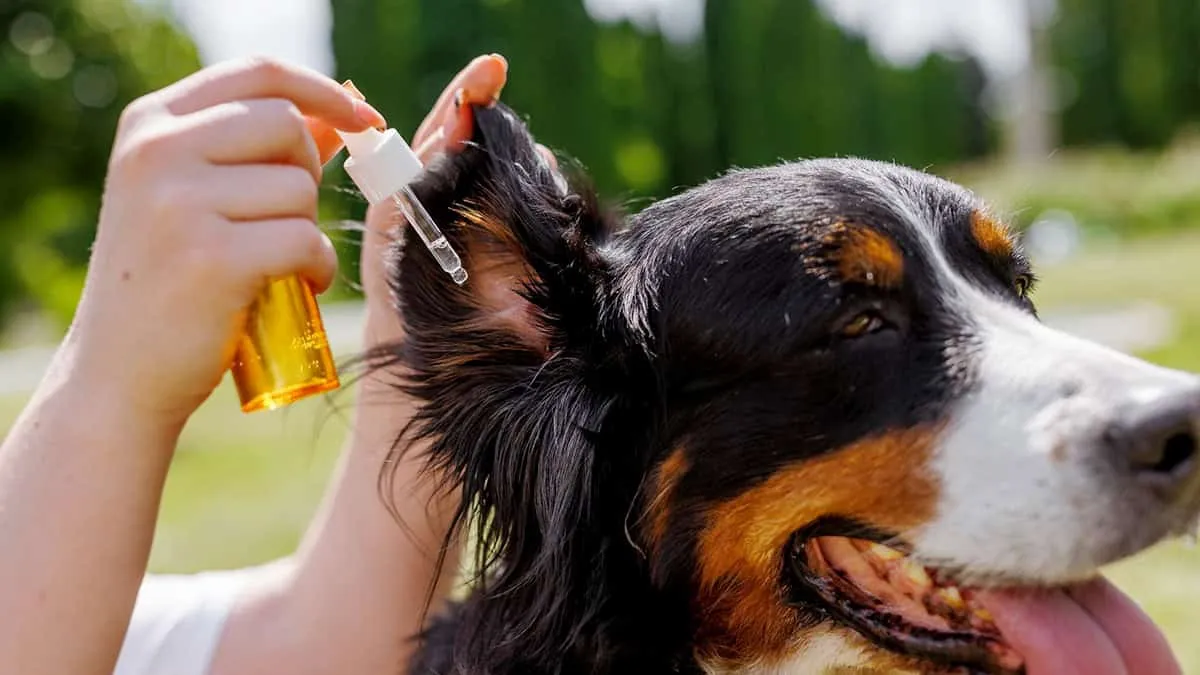Keeping your dog’s ears clean and healthy is a cornerstone of their overall well-being. Neglecting ear care can quickly lead to painful infections, irritating mites, and persistent fungus, significantly impacting your dog’s quality of life and potentially leading to more severe issues like hearing loss. Fortunately, the right ear drops for dogs can be a game-changer, offering relief and preventing future complications. This guide will equip you with the knowledge to choose the best ear drops for your canine companion and understand why ear health is so crucial.
Ear health is paramount for your dog’s comfort and happiness. When a dog’s ears become unclean, they are susceptible to a range of problems. The unique structure of a dog’s ear canal can trap debris and moisture, creating an ideal breeding ground for bacteria and yeast. This not only causes discomfort but can also lead to increased sensitivity and pain due to the delicate nature of their hearing apparatus. Recognizing the importance of ear health is the first step toward ensuring your dog lives a happy, pain-free life.
What to Look For in the Best Ear Drops for Dogs
When selecting ear drops for your dog, several key factors should guide your decision to ensure you choose the most effective and safe product.
- Targeted Treatment Needs: Identify the specific issue you need to address. Ear drops are formulated to combat different problems, including those caused by bacteria, fungus, or ear mites. Knowing the cause of your dog’s discomfort will help you narrow down your choices.
- Key Ingredients: Prioritize ear drops that are vet-approved and contain beneficial ingredients such as antifungals, antibiotics, or anti-inflammatories. Equally important is to be aware of any ingredients your dog may have adverse reactions to and avoid them. Always consult your veterinarian if you are unsure about specific ingredients.
- Ease of Administration: The application process can be a significant factor, especially if your dog is anxious or has sensitive ears. Look for user-friendly packaging, such as bottles with precise droppers or convenient single-use vials, which can make the process smoother for both you and your pet.
Antibiotic Ear Drops for Dogs: Tackling Bacterial Infections
Bacterial ear infections are a common ailment in dogs and can cause significant pain and discomfort. Antibiotic ear drops are specifically designed to target and eradicate the bacteria responsible for these infections, thereby reducing inflammation and alleviating your dog’s suffering.
Otomax
Otomax is a well-regarded option for treating ear infections caused by bacteria and yeast. It combines gentamicin, a potent antibiotic, with betamethasone, an anti-inflammatory agent. This dual-action formula makes it effective for infections with multiple or unknown origins, providing comprehensive relief for your dog.
Baytril Otic
For recurrent or particularly stubborn bacterial ear infections, Baytril Otic can be an excellent choice. This formulation works by targeting both bacteria and fungi with its active ingredients, enrofloxacin (an antibiotic) and silver sulfadiazine (an antifungal). If your dog suffers from persistent ear issues, this could be a valuable addition to your pet care arsenal.
Polysporin Otic Solution
Polysporin Otic Solution is a broad-spectrum antibacterial treatment highly effective for early-stage ear infections. Its primary ingredients, polymyxin B and bacitracin, work together to combat a wide range of bacteria. In some instances, this solution can even serve as a preventative measure for dogs prone to regular infections, helping to maintain ear health over time.
 Dog's ear canal illustration
Dog's ear canal illustration
Antifungal Ear Drops for Dogs: Combating Yeast and Fungus
Yeast and fungal overgrowth can lead to itchy, irritated, and infected ears in dogs. Keeping antifungal ear drops on hand can be crucial for promptly addressing these common issues and preventing them from escalating.
Surolan
Surolan is a versatile antifungal treatment that also addresses bacterial infections due to its active ingredients, miconazole and polymyxin B. This product is effective and can be an affordable option when sourced through international and Canadian pharmacies, making it accessible for many pet owners.
Mometamax
Mometamax is a highly effective brand-name antifungal treatment that also incorporates anti-inflammatory properties. It contains mometasone to reduce inflammation and clotrimazole to combat fungal infections. This makes it a great choice for providing quick relief from itchiness and irritation in your dog’s ears.
Ear Mite Drops for Dogs: Eliminating Parasitic Pests
Ear mites are tiny parasites that can infest a dog’s ear canal, causing significant irritation, redness, and relentless itching. They are particularly common in puppies and multi-pet households. Left untreated, ear mite infestations can lead to more severe ear problems.
Revolution
Revolution is a popular and effective medication for treating ear mites. Its active ingredient, selamectin, targets both immature and adult mites, helping to eliminate the infestation after just one or two treatments. Its broad-spectrum action makes it a trusted choice, especially for new dog owners.
Milbemite Otic Solution
Milbemite Otic Solution is another effective treatment for ear mites that can be used for both dogs and cats. This simplifies treatment for households with multiple pets. The active ingredient, milbemycin oxime, is an antiparasitic agent that targets adult mites, helping to break the cycle of infestation. A significant benefit is that it comes in easy-to-use single-dose application vials, ideal for skittish pets.
Trezaderm
Trezaderm offers a comprehensive approach to ear issues, as it contains both an antifungal agent (thiabendazole) and an antibiotic (neomycin). This dual action makes it suitable for dogs suffering from mixed ear problems, including ear mites, fungal infections, and bacterial issues.
Other Anti-Infection Ear Drops for Dogs
Beyond the specific examples, a variety of other antifungal, anti-mite, and antibacterial ear drop options are available. Discussing alternatives like Animax, Osurnia, GentaVed, DermaVet, Quadruple Ointment, MalaKET Plus, Claro, and Posatex with your veterinarian can help you find the perfect fit for your dog’s unique needs.
Over-the-Counter (OTC) Ear Drops for Dogs: Accessible and Convenient
For dogs experiencing mild ear irritation or chronic but manageable ear infections, over-the-counter ear drops can be a readily available and affordable solution. These products are ideal for a preventative approach or for managing less severe conditions.
NaturPet Ear Drops
NaturPet Ear Drops are formulated to address mild ear itching and irritation, and they can also help clear away wax buildup. Containing natural oils like tea tree, calendula, and echinacea, these drops are a good all-natural remedy, especially for dogs with sensitive ears.
Zymox Otic Solution
Zymox Otic Solution utilizes a potent enzyme-based formula to naturally break down pain-causing fungi and bacteria. This makes it an effective treatment for infections and inflammatory responses in their earlier stages, promoting a healthier ear environment for your dog.
Vetericyn Plus Antimicrobial Ear Rinse
Vetericyn Plus Antimicrobial Ear Rinse provides a gentle yet thorough cleansing for irritated ears. It contains hypochlorous acid, a safe and non-toxic ingredient, making it suitable for regular use to treat minor ear irritation and maintain ear hygiene.
Ear Cleansers for Routine Maintenance
Proactive ear care is one of the most effective strategies for preventing ear infections and mite infestations. Regular use of a high-quality ear cleanser can significantly reduce the risk of these issues with minimal stress for both you and your dog.
Virbac Epi-Otic Advanced Ear Cleanser
Virbac Epi-Otic Advanced Ear Cleanser is a dual-purpose product that cleans and deodorizes your dog’s ears. It is alcohol-free and formulated to reduce both bacteria and yeast, making it safe for use on even sensitive canine ears.
Vetnique Oticbliss Medicated Dog Ear Cleaner
Vetnique Oticbliss Medicated Dog Ear Cleaner offers a two-in-one benefit by combining a cleansing agent with a soothing aloe treatment. This helps remove debris and buildup while simultaneously reducing mild irritation, providing comprehensive care for your dog’s ears.
Verbac Cerulytic Wax Breakdown Solution
For stubborn ear wax, Verbac Cerulytic Wax Breakdown Solution is an excellent choice. This cleansing treatment effectively softens and removes even the most persistent ear wax. For optimal results, it is often recommended to use a general ear cleanser first to prepare the ear canal before applying this wax-targeting solution.
Other Cleaning Solutions to Consider
If the previously mentioned cleaning products don’t meet your dog’s needs, a variety of other effective options are available. Consulting with your vet about products like Imrex Ear Cleaner, Dechra EpiKlean Ear Cleanser, MalAcetic Aural Dog & Cat, and Vetoquinol Ear Cleansing Solution can help you find the best match for your dog’s ear health regimen.
 Veterinarian examining a dog's ear
Veterinarian examining a dog's ear
Pain Relief and Anti-Inflammatory Drops
Dogs suffering from chronic ear issues or frequent severe infections often experience persistent pain and swelling. For these pets, pain relief and anti-inflammatory ear drops can significantly improve their comfort and overall well-being.
Zymox Plus
Zymox Plus is formulated with hydrocortisone to provide pain relief and a blend of enzymes that offer antibacterial action. When used as directed, it can effectively reduce pain, inflammation, and even mild infections, offering much-needed comfort to your dog.
Synotic
Synotic combines an anti-inflammatory agent, fluocinolone acetonide, with a pain reliever, dimethyl sulfoxide. This powerful combination helps to reduce chronic inflammation in dogs experiencing recurring ear irritation, providing substantial relief.
Depo-Medrol
Depo-Medrol is a corticosteroid treatment that is highly effective for a wide range of inflammatory conditions. While typically administered by a healthcare professional as an injection, its rapid action and effectiveness make it a potent option for severe inflammation.
Other Pain Medications to Consider
If your dog requires alternative pain management strategies, discussing options such as Vetericyn and Cort/Astrin with your veterinarian can provide additional avenues for reliable relief from ear-related discomfort.
Administering Ear Drops: A Step-by-Step Guide
Proper application of ear drops is crucial to ensure they work effectively and provide the intended benefits for your dog. Following a simple, consistent procedure can make the process easier and more successful.
Step 1: Clean the Ears
Before applying any ear drops, it’s essential to clean your dog’s ears to remove excess debris, oil, and wax. Use a veterinarian-approved ear cleanser and a soft cotton ball or cloth to gently wipe the ear flap. A clean ear canal ensures that the medication can be absorbed more effectively.
Step 2: Apply the Ear Drops
Carefully uncap your chosen ear drops. Hold the dropper just above your dog’s ear canal and gently squeeze the recommended number of drops into the ear. Ensure you are using the correct dosage as advised by your veterinarian or the product instructions.
Step 3: Massage the Ear
Many ear drop instructions recommend a gentle massage to help distribute the medication evenly throughout the ear canal. With clean hands, gently massage your dog’s ear for about 30 seconds. This action helps the drops penetrate deeper and reach all affected areas.
Step 4: Reward Your Dog
After administering the ear drops, it’s vital to positively reinforce the experience for your dog. Offer praise and treats to help create a positive association with the process. This is especially important if your dog was anxious or resistant, as it will encourage better cooperation during future treatments.
 Person giving medication to a dog
Person giving medication to a dog
Choosing the best ear drops for your dog is a critical step in maintaining their health and comfort. Always consult with your veterinarian to get a proper diagnosis and personalized recommendations for your dog’s specific ear condition. They can guide you toward the most effective treatments, ensuring your furry friend enjoys a healthy and happy life.
